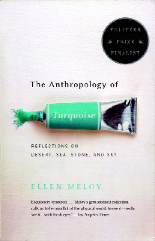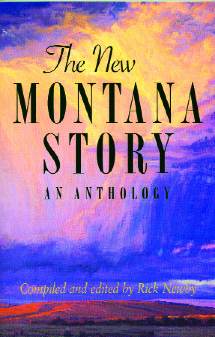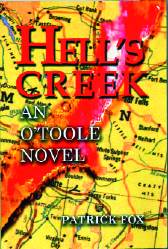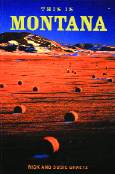Books
By Paddy MacDonald
 The Anthropology of Turquoise Reflections on Desert, Sea, Stone, and Sky
The Anthropology of Turquoise Reflections on Desert, Sea, Stone, and Sky
By Ellen Meloy, M.S. ’79
New York: Vintage Books, a Division of Random House, Inc., 2002, 324 pp., $14.00
Ellen Meloy’s meticulously crafted book, a Pulitzer-prize finalist, is a geographical, emotional, and philosophical journey—an artistic, thought-provoking blend of meditation, memoir, and natural history with strategically placed, startling bursts of humor tossed in the mix.
The book opens with an examination of color—its texture, language, power, and the response it provokes in humans: “irresponsible” yellows, “vainful” pinks, the “demands of green,” the “highway-cone authority” of orange, and, of course, turquoise blue: “. . . you can fall right into it head first, something I tried often as a child. Blue was a good place to go, a country unto itself, transcendent and calm . . ..”
From the Colorado Plateau to the Gulf of Mexico, Meloy drenches us in sensory delights, from the bloom of desert paintbrush and the smell of rain to the exquisite, mind-numbing beauty of parrot fish. Along the way, she examines dreams, myths, and the mysteries of the natural world. Planting readers in the Mojave Desert, she probes at the underlying terror we have of our own powerlessness: “Even today . . . there lingers the knowledge that the heat and aridity can kill you, and if they do not, you might die from the intimidating despair evoked by a vast emptiness that is wholly indifferent to your existence.”
Interspersed among philosophical musings are touchingly rendered passages detailing Meloy’s own early myths: “I thought I was a boy . . . stuck in a messy but minor anatomical complication that would eventually sort itself into a more certain gender.” Meloy gives voice to universal childhood angst as she processes her frustration with the dictums handed down by her Calvinistic father—“This family shall not stay in a motel with a swimming pool”—her mistrust of the adults’ version of her family history—“Too often the lives of my relatives seemed to come as resumés”—and the underlying suspicion that she might be “one animal that faces west when all the others face east . . . that drinks backward at the waterhole.”
Meloy celebrates the radiance, the “full chase of beauty” that confronts us every day. Above all, she exhorts us to pay attention to the natural world and to pass it on to our children, that they, too, may have the “chance for similar experiences of solitude, peace, and quiet even if we have to stay home strapped to our sofas, sobbing with envy while they go.”
 The New Montana Story An Anthology
The New Montana Story An Anthology
Compiled and edited by Rick Newby ’76
Helena: Riverbend Publishing, 2003, 328 pp., $21.95
Rick Newby’s anthology showcases a Montana-specific smattering of the stories we tell ourselves and each other to enhance experience, dissipate grief, or facilitate emotional survival. Secrets, fantasies, and lies—necessary components of these stories—abound in Newby’s judicious selection of fiction and non-fiction.
In “Haircut,” Ruth McLaughlin describes her impoverished childhood and the intrepid means she took to overcome its limitations. In her bedroom, using a clarinet reed as a guide, the high school-aged narrator cuts her hair into three-inch lengths with a razor blade. At school, she’s able to fob off the new hairdo as a salon cut. “Each day I kept my secret was a triumph,” the girl says, as she generates one small success into gutsier, more significant ones.
Aaron Parrett, in “Side of the Road,” recounts growing up with an alcoholic father and the disparate stories—those of a drunk man and those of a sober one—he needed to learn in order to “live with the contradiction of mixed impulses.”
In “A Lot of Living to Do” by David Horgan, the narrator inhabits a complex network of lies, beginning with the whopper, “I came home to, quote, get my act together, unquote.” During each of Nick’s weekly nursing home visits to his grandmother Sylvia, he’s inundated with mendacity, from the falsely cheerful “Hollywood-style old lady” hawking adult diapers on television to the startling delusions that slip in and out of the patients’ enfeebled minds. The story ends on a glorious, triumphant note, however, as Nick throws in his lot with those patients who cling to the fantasies—however bizzarre—that allow them to live out their final years with pizzazz.
In making his selections, Newby strove for a fresh approach—but also restricted stories to those that relate to Montana reality, “however each author prefers to define that reality.” Montana remains front-and-center, from Fred Haefele’s humorous take on the state’s “unique brand of celebrity” following the Kaczynski and Freeman incidents to Ron Fisher’s account of the Speculator Mine disaster in “Manus Dugan” to Deirdre McNamer’s story of an inventive Montana real estate agent cashing in on the hordes of people rushing west to grab “a foothold in the last best place, as more of them bashfully put it.”
 To The Bone
To The Bone
By Neil McMahon, M.F.A. ’79
New York: HarperCollins Publishers Inc., 2003, 244 pp., $23.95
In this tantalizing mystery, Neil McMahon’s third, we’re again following the roller-coaster career of Dr. Carroll Monks. Monks, who spent ten years as a malpractice insurance company investigator, is an ER physician in San Francisco. Divorced, he lives with three cats who prowl the house “like thugs demanding tribute.” Monks has a checkered past, some serious relationship issues, drinks too much, and frequently butts heads with his fellow physicians.
The story opens with a woman’s frantic call to 911. An ambulance soon delivers young, beautiful Eden Hale to Mercy Hospital’s emergency room in critical condition with unexplained respiratory depression. Monks, after cataloguing her symptoms, makes an unusual treatment choice, against the opinions of his colleagues. In spite of—or maybe because of—Monks’ efforts, the patient dies.
This isn’t Monks’ first contentious emergency room situation. Years earlier, at a different hospital, he’d fought and won a wrongful death lawsuit, but discovered in the process that “he had been mistaken about many things, and people, that he had taken for granted.”
In the face of Mercy Hospital’s Quality Assurance committee hearing, possible legal ramifications, and Monks’ own uncertainty about his decision, he sets off, with his friend and former investigative partner, Stover Larrabee, to unravel the mystery of Eden Hale’s death.
Monks’ quest steers him into the center of America’s obsession with youth and beauty, and a Pygmalion-like plastic surgeon who turns that obsession into cash. As Monks digs into Eden’s past he finds himself drawn deeper into a seamy world, a world that “glittered on the surface but was lined with broken glass.”
As he becomes disenfranchised with his place of employment and distanced from Martine, the significant woman in his life, Monks begins a race that, should he fail to win, could mean losing it all: “When things started to go wrong, they seemed to go like an avalanche—first a few rocks that you might be able to dodge, but then the whole mountainside tearing loose and coming down on your head.”
McMahon knows the idiosyncrasies of medicine, and he knows California’s hot-tub-and-Cristal crowd. The readers’ glimpse at a privileged, self-absorbed culture is a fascinating one, and the clues keep us turning pages.
 Hell’s Creek
Hell’s Creek
An O’Toole Novel by Patrick Fox ’88
Lincoln, NE: Charles Patrick Fox, 2003, 201 pp., $14.95
This mystery novel opens with a lightning-paced, corpse-strewn journey that takes the reader from Washington, D.C., to England to Montana. The action centers on a conspiracy tied to an earthquake that occurred fifteen miles northwest of West Yellowstone in 1978. The story is a conglomerate of politics, history, science, fishing, and enough cliff-hangers and red herrings to keep the reader’s interest. Fox’s descriptions of Montana weather are almost James Lee Burke-ian in their lavish, richly-textured detail, and the text comes alive with its liberal sprinkling of hard-baked, taciturn Montana characters.
 This is Montana
This is Montana
By Rick Graetz’68 and Susie Graetz ’67
Helena: Northern Rockies Publishing, 2003, 440 pp., $25.00
The Graetz’s well-indexed collection of essays, photography, and maps serves up a comprehensive guide to Montana’s landscape and its physical, historical, economic, and cultural geography. The text, revised and expanded versions of Rick Graetz’s syndicated newspaper column and lectures from the UM geography course he teaches (augmented by Susie Graetz’s photographs), gives a chronological framework to Montana’s development, as well as a regional breakdown. Writings of such luminaries as A.B. Guthrie, Richard Hugo, Harry Fritz, and K. Ross Toole are interspersed throughout the book.
Father Nature
Fathers as Guides to the Natural World
Edited by Paul S. Piper ’75 and Stan Tag
Iowa City: University of Iowa Press, 2003, 181 pp., $19.95
The nineteen personal essays in this collection chronicle the rewards and challenges of fatherhood, the ways that fathers shape their children’s lives, and how often the love between fathers, daughters, and sons is expressed through experience in nature. The stories brim over with tide pools, fishing holes, birds, redwood groves, ice, trees, and small animals—and they explore the essential role of the natural world in the experiences of having a father, growing up to become a father, and of losing a father.
 The China Files
The China Files
By Doug Moulton ’64
Bloomington, IN: Doug Moulton, 2003, 376 pp., $15.50
This political thriller opens with the disappearance of ex-Army Ranger Nathan Davis, who vanishes after illegally recording a meeting between the U.S. Secretary of Commerce and Chinese government officials. The resulting series of events culminates in an unauthorized military strike into the heart of Shanghai—an operation United States President Wilson Weber is unaware of until Harrier aircraft are only miles off the coast of China. Read carefully: One of the characters is rumored to be based on President George Dennison, another on Alumni Association Director Bill Johnston.